Inscriptions, texts nos. 1-19. Main monumental and annalistic inscriptions
Browse the RIA 5 Corpus [/riao/ria5/pager/]
Quick links
Balawat Gates, main inscription (no. 5)
Statue to Adad of Kurbail (no. 12)
Black Obelisk, main inscription (no. 14)
High Priest-Statue from Nimrud (no. 16)
1 2 3 4 5 6 7 8 9 10 11 12 13 14 15 16 17 18 19
1
A stone slab bearing the account of the first campaigns of Shalmaneser was found in a repository of miscellaneous furniture at Fort Shalmaneser (room NE 26) in Nimrud, together with other five similar slabs dated to the reign of Shalmaneser's father, Ashurnaṣirpal II and originally coming from the city walls (see this ruler's text no. 26 [/riao/ria4/inscriptions/texts2039/index.html#ashurnasirpal226]). Although badly damaged, the slab — which measures 57x68.5 cm — has been proven to bear the earliest known version of the annals, celebrating the ruler's enterprises up to the second palû, and must have been therefore written in that same year (857) or early in the following one. A comparison with Shalmaneser's Kurkh Monolith (here, text no. 2) reveals the presence of many duplicate passages, but more epithets and more details about the campaigns in the present one.
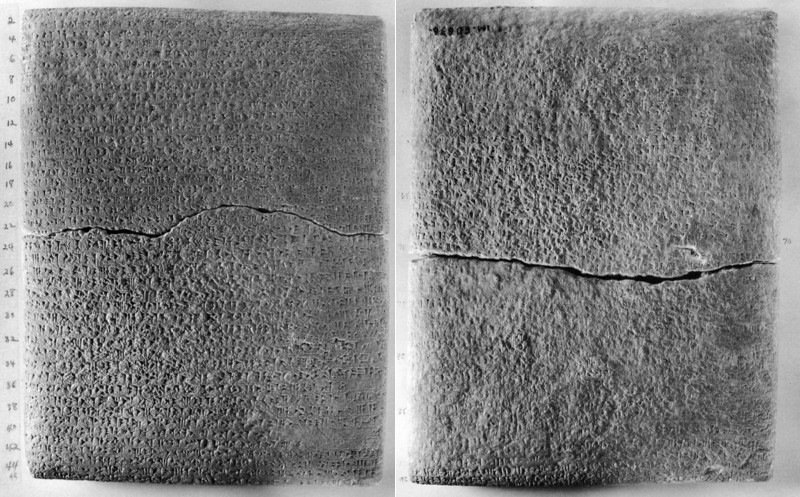
IM 060636, Yamada 2000, fig. 5-6.
After a long introductory section dedicated to royal name and epithets (ll. 1-13), three campaigns are described: in the accession year (859), to the north (via Aridu) against Ḫubuškia, Nairi, and Urarṭu (ll. 14-40a; cf. text no. 2 I 14-28); in the first year (858), to the west against Bīt-Adini and Tīl-Barsip, and across the Euphrates to fight a coalition of states and then to climb the Amanus range (ll. 40-82′a, cf. text no. 2 I 29-ii 13a); in the second year (857), to the west again, across the Euphrates (ll. 82′b-95′, cf. text no. 2 ii 13-18a, where the two text differ substantially). The text ends abruptly without building section nor concluding formulae.
Access the composite text [/riao/ria5/Q004606/] of Shalmaneser III 01.
Bibliography
2, Kurkh Monolith
An early version of the annals is engraved on a large stone stele (220 cm high) found together with a similar one dated to the reign of Ashurnaṣirpal II in the city of Kurkh (Üçtepe) in the Turkish province of Dyarbakir in 1861. The so-called (Shalmaneser's) Kurkh Monolith depicts the ruler in a gesture of salutation while above him divine symbols are carved in relief and the inscription is engraved on to columns across the image and on the back of the stele. A feature common to both Kurkh Monoliths, is the abrupt end of the inscription, without concluding passages of sort, like building section and blessing and cursing formulae (for Ashurnaṣirpal II's monolith, see this ruler's text no. 19 [/riao/ria4/inscriptions/index.html#ashurnasirpal219]). The last narrated event in the inscription is the well known battle of Qarqar (853 BC), which makes it probable a date around that same year or early the year after. A characteristic that is shared by the two monuments is the lack of care, possibly the haste, in which they were both written, which also brought to several scribal errors.
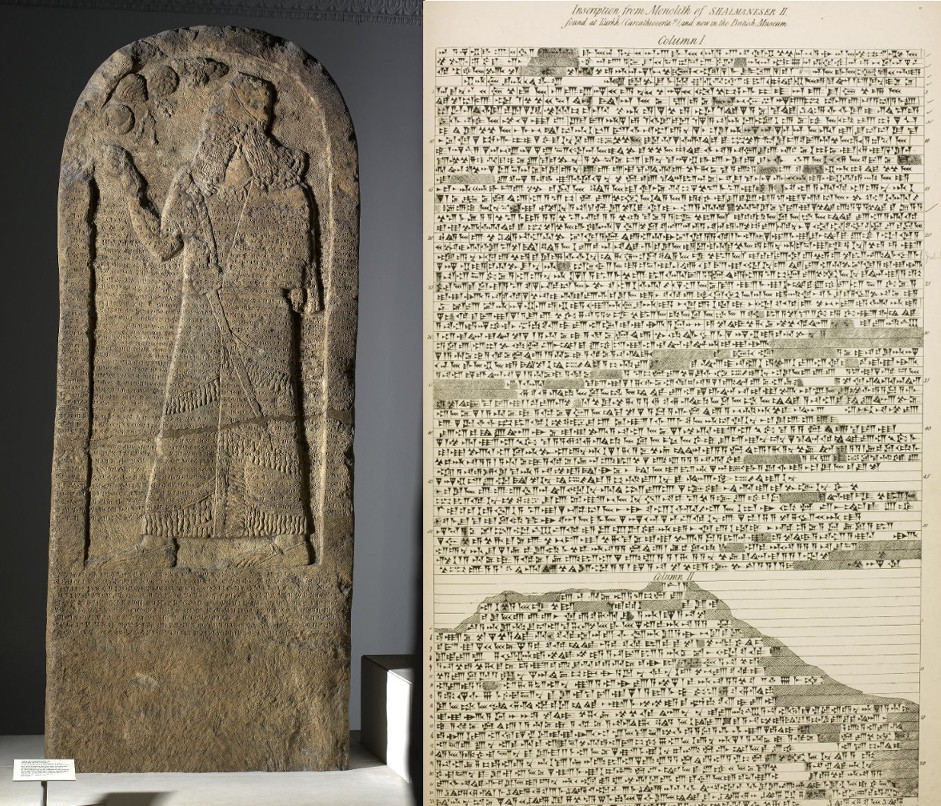
BM 118884 © The Trustees of the British Museum + 1870 3 R pls. 7-.
The text starts with an introductory part that includes the invocation of the gods, the royal names, the epithets and genealogy (ll. I 1-13), and is followed by the "annalistic" section in chronological order: to the north (via Aridu) against Ḫubuškia, Nairi, and Urarṭu (I 14-28; accession year: 859), to the west against Bīt-Adini and Tīl-Barsip, and across the Euphrates to fight a coalition of states and then to climb the Amanus range (i 29-ii 12; first year: 858), to the west again, across the Euphrates (ii 13-29; second year: 857), across the Upper Euphrates and northwards to the Sea of Nairi (ii 30-65; third year: 856), across the Upper Euphrates again (ii 66-77; fourth year: 855). Finally, after omitting the campaign into the Mount Kašiyari, the inscription ends with a celebration of the battle of Qarqar in 853 (sicth year, ii 78-102).
Access the composite text [/riao/ria5/Q004607/] of Shalmaneser III 02.
Bibliography
3
A large stone slab (68.5x44 cm) found in the Nabû Temple at Nimrud is engraved with an inscription that almost duplicates the one inscribed on the so-called "Kurkh Monolith" (see text no. 2), save for the last fifteen lines. Furthermore, the text ends abruptly after the narrative of the first military campaign (858 BC). Therefore, it is believed that the one that we have was but the first of a series of slabs inscribed with this version of the annals. A similar example of annals series is also known from Ashurnaṣirpal (text no. 1 [/riao/ria4/inscriptions/index.html#ashurnasirpal201]) and Adad-nerari III (text no. 1). The beginning of another annals series from Ashur is edited here as text no. 15.
Access the composite text [/riao/ria5/Q004608/] of Shalmaneser III 03.
Bibliography
4
A large stone slab (177x98 cm) was found at Til Barsip (Tell Ahmar). It bears an inscription of thirty lines on the obverse and seventeen on the left edge, where the text stops abruptly, although there is room enough for more lines. The so unfinished inscription opens with an invocation to the gods, royal name and genealogy that are identical with those of text no. 2 (i 1—12a). It then follows the beginning of what it seems to be an account of Shalmaneser's conquests in geografical order.
Access the composite text [/riao/ria5/Q004609/] of Shalmaneser III 04.
Bibliography
5 - Balawat Gates, main inscription
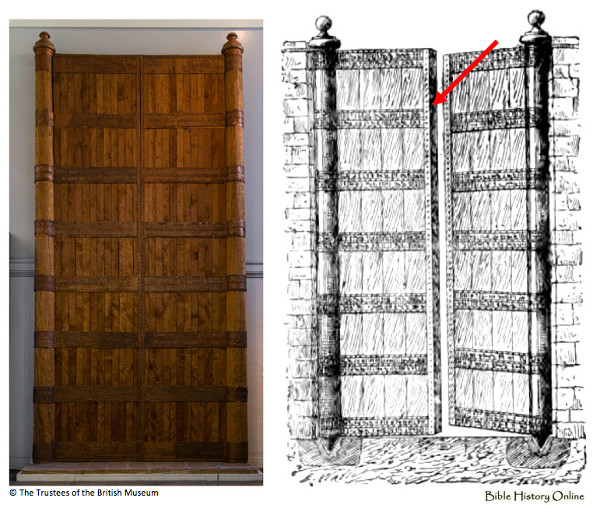
BM 124667 + BM 128156. Elaboration from bible-history.com and © The Trustees of the British Museum.
This is the main text of the inscription engraved on the bronze
gates discovered at Imgur-Enlil, modern-day Balawat. The monument
presents two kinds of inscription: a main text, the one presented
here, and a group of epigraphs, which are here edited as texts
nos. 63–86 [/riao/ria5/shalmaneseriii/texts6386/index.html].
The present text was written in two exemplars on each of the two
bronze coverings that were attached to the edge of the gate leaves, at
the point where they meet. Both exemplars have a number of lacunae and
are, in the words of Grayson,
(who made the present edition), "rather carelessly inscribed, with several errors, omissions, and inconsistent spacing of signs."
The monument is still waiting, after more than a century from its first appearance, for a comprehensive publication, as the one recently offered for the Balawat Gates of Shalmaneser III's father, Ashurnasirpal II (Curtis and Tallis 2008).
As for the contents, the inscription begins with Shalmaneser's name, titles, genealogy and epithets (i 1 – ii 1), followed by a brief record of the campaigns to Ḫatti and the Mediterranean in 858 BC (ii 2–24), Urarṭu in 856 BC (ii 5 – iii 2), Bīt-Adini in 855 (iii 3–6), and a more detailed celebration of the two Babylonian camapaigns in 851–50 BC (iv 1 – vi 7). The text ends abruptly, with no concluding formulae or record of the works at Imgur-Enlil.
Access the composite text [/riao/ria5/Q004610/] of Shalmaneser III 05.
Bibliography
6
The present text was found on several exemplars on clay tablets. It
is a version of Shalmaneser's annals that follows a chronological
order of narration of the military conquests of the ruler, which is
followed, however, by a résumé of the conquests in geographical order and by a
further section dedicated to other ideological topoi, as royal
hunting, agricultural abundance under Shalmaneser's rule, and
greatness of the Assyrian army. Such themes are an echo of the similar
ones introduced by the Middle-Assyrian king Tiglath-pilser I [/riao/thekingdomofassyria1114884bc/tiglathpileseri/index.html] in his own inscriptions.
All the retrieved exemplars come from Ashur (ex. 11, found at Nimrud,
which is in fact a different text, a shorter version of the
annals). The only complete inscription, exemplar one, was retrieved in
the outer wall of Ashur together with the stone tablet catalogued as
text no. 10.
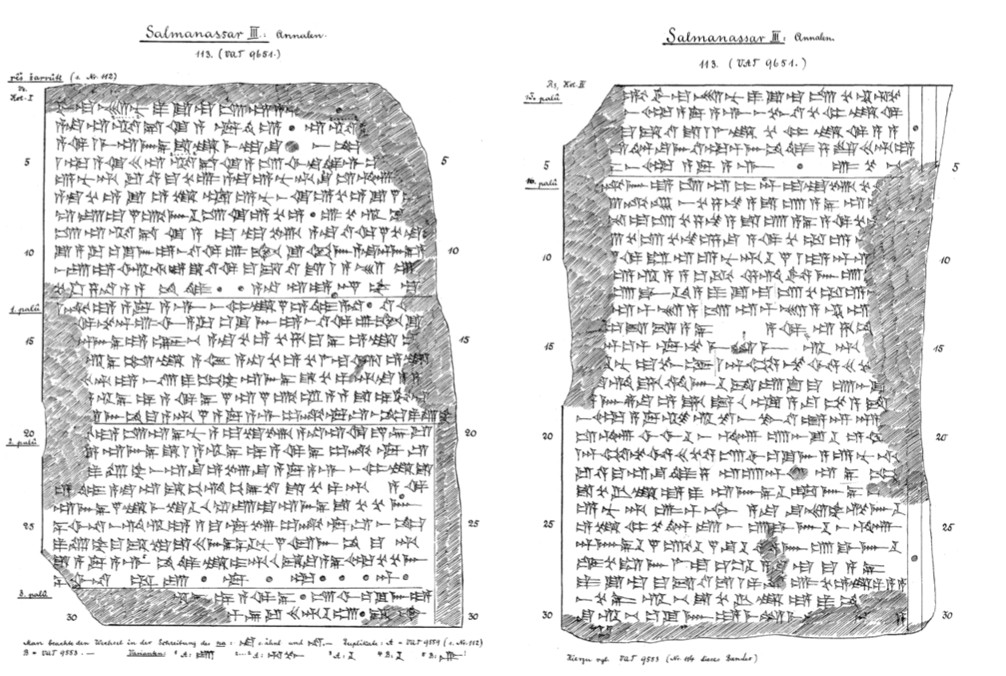
VAT 09651. KAH 2, 113.
The inscription can be divided in three parts: (1) invocation to the gods (i 1-27, almost a duplicate of text no. 2 i 1-11 [/riao/ria5/Q004607/]); (2) chronological narration of military campaigns from the beginning to the sixteenth year of Shalmaneser's reign (i 28 – iv 25); (3) further ideological themes: a short geographical account of conquests (iv 26-36), appointment of governors and regulation of tribute (iv 37-39), royal hunting (iv 40-44), increase of agricultural production (iv 45-46), and tremendous size of the Assyrian army (iv 47-48).
The text ends abruptly with no concluding parts, building accounts or blessings/curses sections, but only a date: 22nd Tašritu of the eponymy of Taklāk-ana-šarri, governor of the city of Nēmed-Ištar, corresponding to the 842 BC.
Access the composite text [/riao/ria5/Q004611/] of Shalmaneser III 06.
Bibliography
7
ND 04369 is edited as Text no. 6 ex. 11.
Access the composite text [/riao/ria5/Q004612/] of Shalmaneser III 07.
Bibliography
8
The present text is a version of the annals that has been reconstructed from the inscriptions engraved on two monumental bulls from Nimrud (exs. 1-2), with the help of two further fragmentary texts on stone objects (exs. 3-4), whose exact nature remains unknown. It should be kept in mind, however, that there is no certainty that these are four exemplars of the same text (see RIMA 3, p. 42-3 on the subject).
The text begins with Shalmaneser's name, titles, epithets, genealogy, and a summury of his conquest arranged geographically (lines 1-40). The second part of the text has more lengthy and detailed descriptions of some of the ruler's regnal years, with two large lacunas. Here, the survived text is concentrated on the third to fifteen regnal years, and to the eighteenth year. Afterwards, the text either ends abruptly or is followed by a third lacuna.
Access the composite text [/riao/ria5/Q004613/] of Shalmaneser III 08.
Bibliography
9
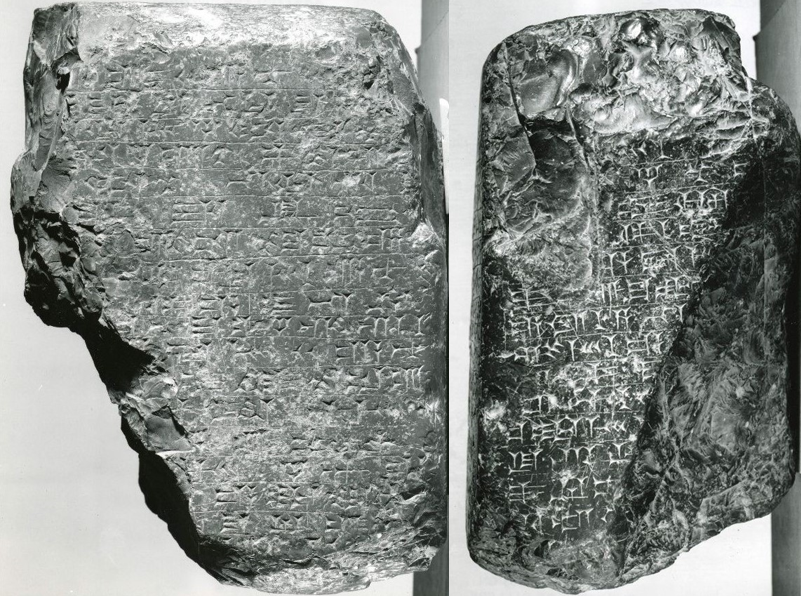
WAM 41.162, The Walters Art Museum
A broken stele now stored in the Walters Art Gallery of Baltimore is said to come from Ashur. Its remains measure 43 × 30.5 ×23+ cm and the inscriptions on its front and right side are the only legible enough to be edited: the front side bears the beginning of the inscription, with name and titles of the ruler, while on the right side is engraved the account of the eighteenth campaign (841 BC). The presence of many lacunas has required the editor to restore the text from parallels:
Access the composite text [/riao/ria5/Q004614/] of Shalmaneser III 09.
Bibliography
10
This stone tablet was found, together with the clay tablet edited here as text no. 6, in the wall of the city Ashur. Two further fragmentary inscriptions – ex. 2, unlocated, collated from photos, and ex. 3 now in Istanbul Museum – have been catalogued as exemplars of the same text, but there is no certainty on the matter.
The text consists in a long version of the annals. It begins with an
invocation of the gods and the name of the ruler with some epithets (i
1-18). Then, the text records the deeds of Shalmaneser during his
first twenty campaigns, followed by some more detailed descriptions of later campaigns and ending with a summary of the booty won (i 19 – iv 39).
The inscription has also a building section, dedicated to the works on the fortification walls of the New City (URU.GIBIL) in Ashur. In this passage, the previous works on the same area performed by Puzur-Aššur III, Adad-nerari I (see text no. , where also the works of Puzur-Aššur are mentioned), Tukulti-Ninurta I (text no.) and Tiglath-pileser I (text no.) are also recorded.
The text ends with the date, the twentieth regnal year (839 BC), and a statement regarding the number of chariots and cavalry in Shalmaneser's army.
Access the composite text [/riao/ria5/Q004615/] of Shalmaneser III 10.
Bibliography
11
A.K. Grayson could collate the present text only from photos, because the stone slab fragment on which it is engraved is known to have been found in Ashur, but has no known present location. As mentioned by the editor, the left edge of the inscription seems to have been divided into two columns, but only one trace of col. i remains.
The text has many similarities with text no. 10. Both texts give account of Shalmaneser's military campaigns up to the twentieth regnal year; both concern with the rebuilding of the wall at Ashur; both text, finally, have a statement on the greatness of the Assyrian army in the final part of the inscription.
The text starts with an invocation of the gods, which reminds the
similar one on the text no. 14 (Black Obelisk, ll. 1-14), followed by
name, titles, genealogy and epithets of the king (obv. 1′-13′a); it
then continues with an account of the first regnal year
(obv. 13′b-19′). Note that a similar textual arrangement is visible also in text no. 10 (ll. 9-24) and 14 (ll. 15-27).
After a long lacuna, the text survives, although fragmentary, on the
reverse of the slab, where it gives an account of the nineteenth and
twentieth regnal years, and a description of the works on the walls of
Ashur, which includes a list of several rulers that performed the
works on the same spot. Notably, the text is almost parallel with
Aššur-rêm-nišešu text no. 1 [/riao/ria1/oldassyrianperiod/mittanianhegemony/ashurremnisheshu/index.html], which suggests that Shalmaneser discovered one or more texts of this kind while rebuilding the walls.
Access the composite text [/riao/ria5/Q004616/] of Shalmaneser III 11.
Bibliography
12, Shalmaneser's statue to Adad of Kurbail (from Fort Shalmaneser)
The present text is engraved on a statue of Shalmaneser (103 cm) that was dedicated to the god Adad of Kurbail. Kurbail was a capital of province in the Assyrian heartland, north of Nineveh and probably towards the frontier of Urartu (possibly in the Kurdish region of Dohuk or in the near Alqoš area), whose exact location is still unknown. The city had a major temple of Adad, but a shrine of the Adad of Kurbail is attested also at Ashur. However, the present statue was found in Nimrud, at Fort Shalmaneser, the ēkal mašarti (Review Palace), of the city, and more precisely in the workshop NE 50. Examinations on the statue revealed that it was most probably stored in the fort in order to be repaired, although the ways in which it arrived there are still debated. The possibility that a shrine of Adad of Kurbail was also present in Nimrud, however, should not be discharged.
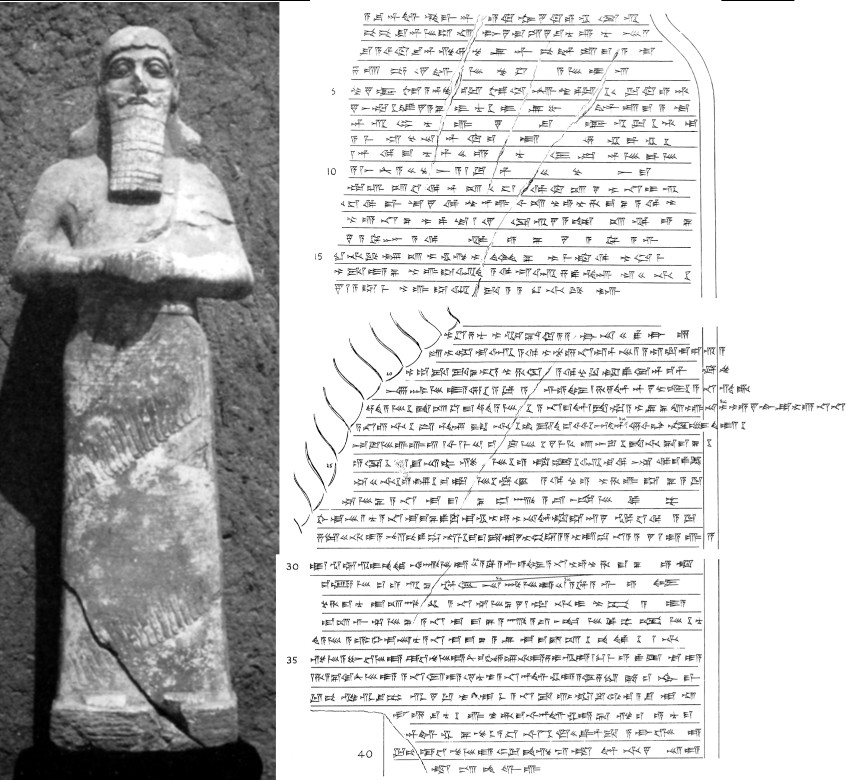
IM 060497. Elaboration from Kinnier Wilson, Iraq 24, pl. 30, 33-35.
The text begins with an elaborated dedication to Adad, to which follow Shalmaneser's name and genealogy (ll. 1-10). A second part is dedicated to a geographically arranged summary of the ruler's conquests (ll. 11-20), and by more lengthy accounts of the campaigns of the eighteenth to twentieth regnal year, the latter being set in the region of Que, whose tribute, received by the end of the campaign, is given to Adad (ll. 21-36a). Finally, the inscription ends with a dedicatory description of the works on the actual statue (ll. 36b-40).
Access the composite text [/riao/ria5/Q004617/] of Shalmaneser III 12.
Bibliography
13
A fragmentary text engraved on a stone slab from Ashur (actual location unknown) was probably written to commemorate the works on the city's Aššur temple, as shown by a fragmentary passage on the left edge of the slab, which closely parallels Shalmaneser I's text no. 1: 160-2. Notably, while the rest of the slab is written with typical Noe-Assyrian signs, the script of this passage is in an "archaic" style, similar to the one used in the inscriptions of the earlier ruler – thus, indicating that the scribes were copying from texts retrieved during the excavation works at the temple.
Traces of text on the obverse and on the reverse of the slab show portions of accounts of Shalmaneser III's military campaigns from the fifteenth to twenty-first regnal years (844-38 BC). The reconstruction of these passages was made possible by their comparison with duplicate texts.
Access the composite text [/riao/ria5/Q004618/] of Shalmaneser III 13.
Bibliography
14 Black Obelisk, main inscription
This is the "main text" engraved on the faces of the so-called
"Black Obelisk," discovered by A.H. Layard in 1846 during
his excavations in Nimrud. The exact provenance of the monument, which
is about two meters in height, has caused debated among
scholars.
The obelisk is remarkable for being almost free of damage, except for
small parts that could be easily restored. On its four sides, four
scenes in each have been engraved, depicting the king's exploits in
different Mesopotamian regions. Each panel has its own epigraph, which
runs along the top side of the scenes for all the four sides. The
epigraphs have been edited here as text nos. 87-91 [/riao/ria5/shalmaneseriii/texts8799/index.html].
The text represents one of the fullest (and latest) accounts of the ruler's military campaigns, providing a narrative for each year up to the thirty-first (828 BC). The first 47 lines are almost identical with text no. 15 of the same ruler. The inscription starts with an invocation to the gods, royal name and epithets (ll. 1-21). It follows a narration of Shalmaneser's campaigns, the last of which (ll. 141-90) had been led by the ruler's field-marshal, Dayyan-Aššur. This is probably at the basis of the rather confusion between third (meant for Dayyan-Aššur) and first (meant for the king) person in the course of the narration.
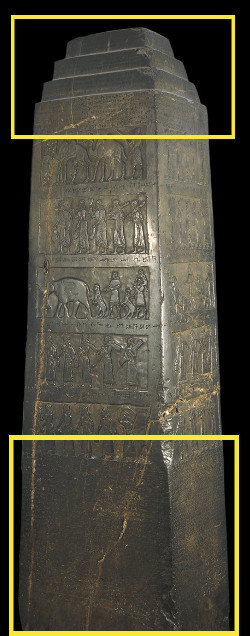
BM 118885. © The Trustees of the British Museum.
Access the composite text [/riao/ria5/Q004619/] of Shalmaneser III 14.
Bibliography
15
The present text has been catalogued by Grayson as an exemplar of
text no. 14. It consists of numerous fragments of a large stone slab retrieved at Ashur (one large piece was found in the temple area) and put together by Unger (RlA 2). Most of the fragments are only known from photos: Ass ph 4952 (ll. 11-15), Ass ph 5055 (ll. 1-3, 43-47), and Ass ph 4958, 5001, and 5056.
The text "duplicates" ll. 1-47 of the Black Obelisk ending abruptly at
the account of the fourth regnal year and the military campaign
against Bit-Adini. Therefore, it has been suggested that the present
slab was the first of a series on which the annals of the ruler's reign would have been recorded.
Access the composite text [/riao/ria5/Q004620/] of Shalmaneser III 15.
Bibliography
16, High Priest-Statue from Nimrud
A white limestone statue in the round of Shalmaneser III (high 1.4 m) was reconstructed from numerous fragments recovered in Nimrud's outer town, near the south-east foot of the acropolis. The statue represents the king dressed in full canonicals for his office as High Priest of the god Ninurta, in whose temple, as suggested by Læssøe, might have been originally stored. The statue is engraved with a ca. 350 ll. inscription which although been full of lacunas was reconstructed through parallels with other Shalmaneser's texts, especially no. 14, Black Obelisk (but also texts nos. 6 and 10, see RIMA 3, p. 73).
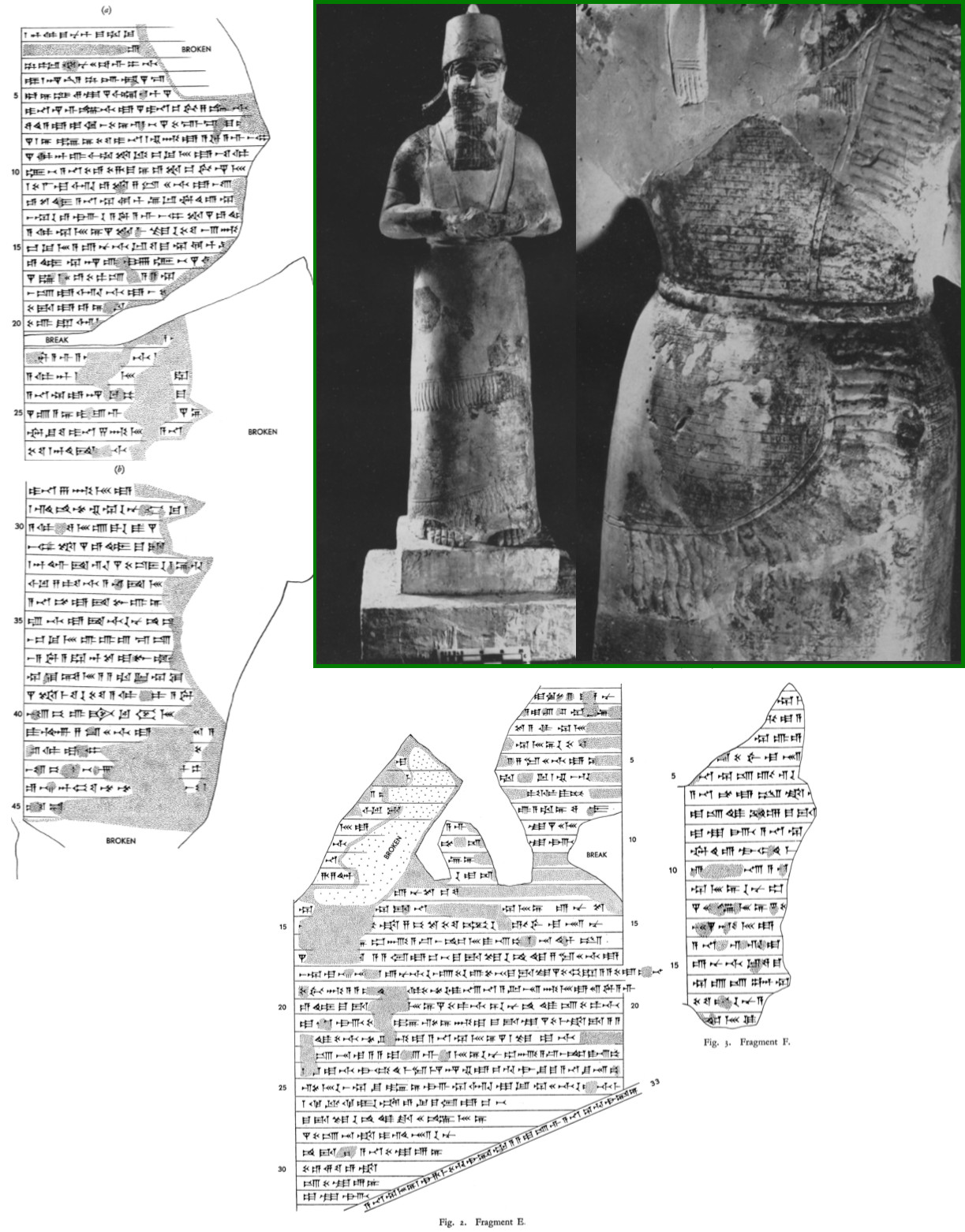
IM 060496. Elaboration from Laessøe, Iraq 21 pl. 40, 42 andd pp. 149, 153, 156.
The text is introduced by the king's name, epithets and genealogy (ll. 1-5). It follows the account of the military campaigns up to 31st regnal year (ll. 6-341′a), ending with a description of a royal hunt and equipment of the Assyrian army (ll. 341′b-348′). The narrative is very similar to that of the Black Obelisk's text, although with some differences. Similarly to what happens in the Black Obelisk, the account of the last campaigns, led by Dayyan-Aššur present sometimes confusion between first and third person as subject of the narrative. Since the last year described is the thirty-first, the text can be dated to 828 or 827 BC.
Access the composite text [/riao/ria5/Q004621/] of Shalmaneser III 16.
Bibliography
17
An unusual text was found inscribed on a tablet discovered in 1951,
during a
British-Turkish expedition to the site of Sultantepe, ancient
Ḫuzirina, situated along a northern extension of the Balikh River. The
tablet was found along with other ca. 400 literary texts in the area
of a private house belonging to a family of a šangu-priest
named Qurdi-Nergal. The text belongs to an unusual typology.
Its structure is that of a royal inscription, i.e. invocation
of gods, royal name and epithets, narrative of a campaign, and
offerings to the gods; even the occasional fluctuation between third and first
person (ll. 39, 59, and 61), which is a quite common phenomenon in
Assyrian royal inscriptions, is also present. However, the text is written in
poetic language with extensive use of direct speech, although without
following the typical characteristics of epics.
A second question related to this text is the uncertainty about its
dating, due to its fragmentary state but also to the afore mentioned
atypical charcter (and therfore lack of parallels). Most scholars date it
to the years of Shalamneser, pointing at this ruler as the protagonist
of the inscription. Nonetheless, a possible attribution to his father,
Aššurnaṣirpal II, is also possible, as elucidated by Julian Reade
(1989). Finally, a question remains open about the use(s) that such
text might have had. It has been suggested (RIMA 3, p. 85) that the
text had been composed to be read out in public in the city Ashur
during the formal celebration of the
festival of Ištar at Arbail, which the king performs in the final
lines. However, such hypothesis is based on the comparison with Sargon II's
Letter to Ashur and the assumption that a public reading would be the
actual function of the latter, an assumption that has been questioned
(Morello 2013, "Percezioni sensoriali... [https://www.academia.edu/1201344/2013_Nathan_Morello_Percezioni_sensoriali_del_paesaggio_montano_nell_ottava_campagna_di_Sargon_II_714_A.C._in_S._Magnani_ed._Le_aree_montane_come_frontiere._Spazi_di_interazione_e_connettività_Udine_441_462]," with previous literature).
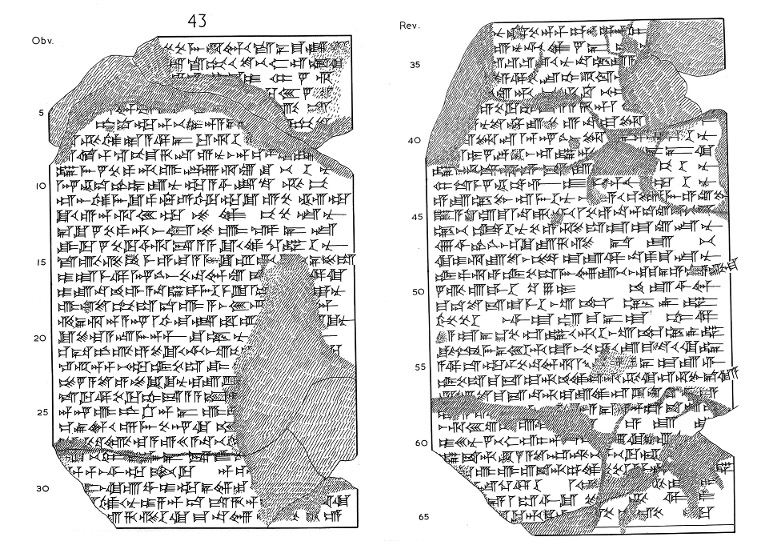
STT 1 no. 43
The inscription opens with an invocation of gods, followed by the name and epithets of the king and a brief statement regarding the defeat of Til-Barsip and the land Ḫatti (ll. 1-9). The following part is dedicated to the direct speech between the king and his turtānu Aššur-bēl-kaʾʾin, in which the ruler commands to keep the region of Tīl-Barsip secure while he leads a campaign against Urarṭu (ll. 10-15). The king then exhorts his officers to mobilize their soldiers and take up arms for the noble venture against Urarṭu (ll. 16-30). Troops are then described marching out with details of the conquests in route, booty taken, and capture and looting of the Urarṭian capital Ṭurušpa (ll. 31-57). The text ends with the king celebrating the festival of Ištar at Arbail and his ceremonial entrance into the Baltil, the oldest quarter of the city Ashur (ll. 58-65).
Access the composite text [/riao/ria5/Q004622/] of Shalmaneser III 17.
Bibliography
18
For an overview of the clay cones belonging to Shalmaneser III's
reign, and their "Types," see the Introduction
to this king.
Four clay cones from Ashur (cf. text no. 42) are engraved with the following inscription, which although very damaged, clearly deals with Shalmaneser's cmapaign in Babylonia during his ninth year of reign (850 BC). The text also records works on the walls of Aššur temple, and in the final lines is dated to the eponymy of Iḫtadī-Ibbušu (849).
Access the composite text [/riao/ria5/Q004623/] of Shalmaneser III 18.
Bibliography
19
A fragment of a stone amulet, the tab protruding from it, measures 7x9 cm and bears an inscription of which about ten lines survive on each face. The amulet was presumably displayed in the Ninurta temple of Nimrud, judging from its initial dedication.
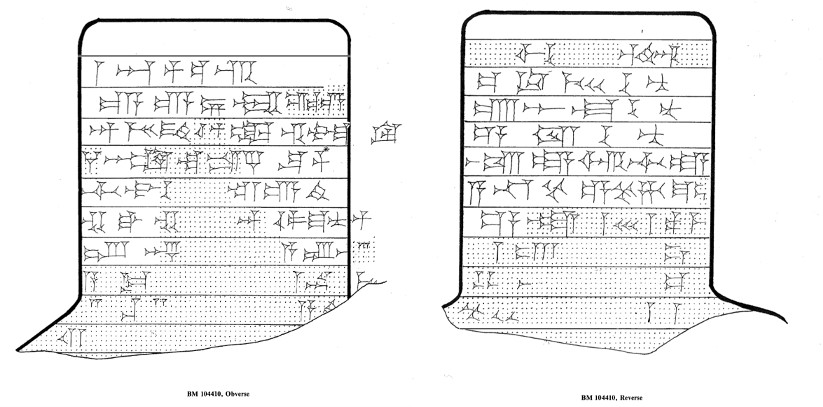
BM 104410, Grayson, ARRIM 9 pp. 19-22.
On the reverse one can read the partial account of a military event and the record of an ascent to the Mount Amanus, possibly to cut cedar beams, which, if compared with the similar phrasing in text no. 6 iii 7–15, might correspond to the eleventh campaign (848 BC).
Access the composite text [/riao/ria5/Q004624/] of Shalmaneser III 19.
Bibliography
Nathan Morello
Nathan Morello, 'Inscriptions, texts nos. 1-19. Main monumental and annalistic inscriptions', RIA 5: Inscriptions of Shalmaneser III and His Successors (858–745 BC), The RIA Project, 2023 [http://oracc.org/shalmaneseriii/texts119/]